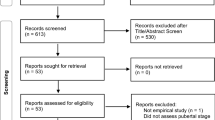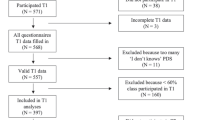Abstract
This study examined the role of pubertal development on depression, externalizing behavior problems, self-esteem, and body-image of 951 Mexican early adolescents. The 5th through 7th grade students were assessed at the beginning and end of the school year. The main finding of this study is that the acute experience of menarche adversely affected Mexican adolescent girls psychological well-being, most specifically in terms of depressive symptomatology. On the other hand, pubertal change in Mexican boys, as measured by voice-change, did not appear to adversely affect psychological well-being above and beyond a nonsignificant minimal and temporal readjustment and in fact had a positive effect on body-image. Results suggest that perceived maternal control, prior social–emotional adjustment, and menstrual attitudes may moderate the effects of pubertal change.
Similar content being viewed by others
REFERENCES
Angold, A., Costello, E. J., and Worthman, C. M. (1998). Puberty and depression: The roles of age, pubertal status and pubertal timing. Psychol. Med. 28(1): 51–61.
Battle, J., Jarratt, L., Smit, S., and Precht, D. (1988). Relations among self-esteem, depression, and anxiety in children. Psychol. Rep. 62(3): 999–1005.
Benjet, C. (1999). Menarche and Depression, Self-Esteem, and Body Image of Mexican adolescent Girls. Unpublished doctoral dissertation, National University of Mexico, Mexico.
Benjet, C., and Hernandez-Guzman, L. (2001). Gender differences in psychological well-being of Mexican early adolescents. Adolescence 36(141): 47–65.
Benjet, C., Hernandez-Guzman, L., Tercero-Quintanilla, G., Hernandez-Roque, A., and Chartt-Leon, R. (1999). Validity and reliability of the CES-D in children and early adolescents. Rev. Mex. Psicologia 16(1): 175–185.
Brooks-Gunn, J. (1988). Antecedents and consequences of variations in girls' maturational timing. J. Adolesc. Health Care 9: 365–373.
Brooks-Gunn, J., and Ruble, D. (1980). Menstrual Attitude Questionnaire. Psychosom. Med. 42: 503–512.
Brooks-Gunn, J., and Ruble, D. (1982). The development of menstrualrelated beliefs and behaviors during early adolescence. Child Dev. 53: 1567–1577.
Brooks-Gunn, J., and Warren, M. (1989). Biological and social contributions to negative affect in young adolescent girls. Child Dev. 60: 40–55.
Brooks-Gunn, J., Warren, M., Rosso, J., and Gargiulo, J. (1987). Validity of self-report measures of girls' pubertal status. Child Dev. 58: 829–841.
Caspi, A., and Moffitt, T. (1991). Individual differences are accentuated during periods of social change: The sample case of girls at puberty. J. Pers. Soc. Psychol. 61(1): 157–168.
Clark, D. B., and Neighbors, B. (1996). Adolescent substance abuse and internalizing disorders. Child Adolesc. Psychiatr. Clin. N. Am. 5(1): 45–57.
Climent, C., Aragon, L., and Plutchick, R. (1989). Prediction of risk for drug use in high school students. Bol. Oficina Sanitaria Panamericana 107(6): 568–576.
Compas, B. E., Connor, J., and Wadsworth, M. (1997). Prevention of depression. In Weissberg, R. P., and Gullotta, T. P. (eds.), Healthy Children 2010: Enhancing Children's Wellness: Issues in Children's and Families' Lives (Vol. 8.). Sage, Thousand Oaks, CA, pp. 129–174.
Cuevas Fournier, L. E. (1969). Psychological Aspects of Menarche. Unpublished doctoral dissertation, National Autonomous University of Mexico, Mexico City, Mexico.
Davis, C., and Katzman, M. (1997). Charting new territory: Body esteem, weight satisfaction, depression, and self-esteem among Chinese males and females in Hong Kong. Sex Roles 36(78): 449–459.
Debold, E., Brown, L. M., Weseen, S., and Brookins, G. K. (1999). Cultivating hardiness zones for adolescent girls: A reconceptualization of resilience in relationships with caring adults. In Johnson, N. G., Roberts, M. C., and Worell, J. (eds.), Beyond Appearance: A New Look at Adolescent Girls. American Psychological Association, Washington, DC, pp. 181–204.
Eccles, J. S., Wigfield, A., Flanagan, C. A., Miller, C., Reuman, D. A., and Yee, D. (1989). Self-concepts, domain values and self-esteem: Relations and changes at early adolescence. J. Pers. 57:283–310.
Faust, M. S. (1983). Alternative constructions of adolescent growth. In Brooks-Gunn, J., and Petersen. A. (eds.), Girls at Puberty: Biological and Psychological Perspectives. Plenum, New York, pp. 105–126.
Ge, X., Best, K. M., Conger, R. D., and Simons, R. L. (1996). Parenting behaviors and the occurrence and co-occurrence of adolescent depressive symptoms and conduct problems. Dev. Psychol. 32(4): 717–731.
Gonzalez-Forteza, C. (1992). Psychosocial Stress and Coping Mechanisms: the Impact on the Emotional State of Adolescents. Unpublished master's thesis, National Autonomous University of Mexico, Mexico City, Mexico.
Gonzalez-Forteza, C. (1996). Buffering and Risk Factors for Depression and Suicide Attempts in Adolescents. Unpublished doctoral dissertation, National Autonomous University of Mexico, Mexico.
Hayward, C., Gotlib, I. H., Schraedley, P. K., and Litt, I. F. (1999). Ethnic differences in the association between pubertal status and symptoms of depression in adolescent girls. J. Adolesc. Health 25(2): 143–149.
Hernandez-Guzman, L., and Caso Niebla, J. (1996). Does child-rearing style influence child self-esteem? Paper presented at the Annual meeting of the National Council in Teaching and Research of Psychology, Mexicali, Mexico.
Hill, J. P., and Lynch, M. (1983). The intensification of gender-related role expectations during adolescence. Brooks-Gunn, E. J., and Petersen, A. (eds.), Girls at Puberty: Biological and Psychological Perspectives. Plenum, New York, pp. 201–228.
Hoffmann, J. P., and Su, S. S. (1998). Stressful life events and adolescent substance use and depression: Conditional and gender differentiated effects. Subs. Use Misuse 33(11): 2219–2262.
Holmbeck, G., and Hill, J. P. (1991). Conflictive engagement, positive affect, and menarche in families with seventh-grade girls. Child Dev. 62: 1030–1048.
Katragadda, C. P., and Tidwell, R. (1998). Rural Hispanic adolescents at risk for depressive symptoms. J. Appl. Soc. Psychol. 28(20): 1916–1930.
Lahey, B. B., Schwab-Stone, M., Goodman, S. H., Canino, G., Rathouz, P. J., Miller, T. L., Dennis, K. D., Bird, H., Jensen, P. S., and Waldman, I. D. (2000). Age and gender differences in oppositional behavior and conduct problems: A cross-sectional household study of middle childhood and adolescence. J. Abnorm. Psychol. 109(3): 488–503.
Leon, G. R., Keel, P. K., Klump, K. L., and Fulkerson, J. A. (1997). The future of risk factor research in understanding the etiology of eating disorders. Psychopharmacol. Bull. 33(3): 405–410.
Martin, K. A. (1996). Puberty, Sexuality, and the Self: Girls and Boys at Adolescence. Routledge, New York.
Morelos Flores, M. (1994). Attitudes and KnowledgeRegarding the Menstrual Cycle of PremenopausalWomen and Girls Beginning to Menstruate. Unpublished undergraduate thesis, National Autonomous University of Mexico, Mexico.
Murray, C. J., and López, A. D. (1997). Alternative projections of mortality and disability by cause, 1990–2020: Global burden of disease study. Lancet 349: 1498–1504.
Nolen-Hoeksema, S., and Girgus, J. (1994). Gender differences in depression during adolescence. Psychol. Bull. 115: 424–443.
Pappini, D., and Sebby, R. (1987). Adolescent pubertal status and affective family relationships: A multivariate assessment. J. Youth Adolesc. 16(1): 1–15.
Patton, G. C., Hibbert, M. E., Carlin, J., Shao, Q., Rosier, M., Caust, J., and Bowes, G. (1996). Menarche and the onset of depression and anxiety in Victoria, Australia. J. Epidemiol. Community Health 50(6): 661–666.
Petersen, A. (1980). The Self-Image Questionnaire for Young Adolescents. Laboratory for the study of adolescence, Michael Reese Hospital and Medical Center, Chicago, IL.
Petersen, A., Sarigiani, P., and Kennedy, R. (1991). Adolescent Depression: Why more girls? J. Youth Adolesc. 20(2): 247–271.
Pope, A., McHale, S., and Craighead,W. E. (1988). Self-esteem Enhancement With Children and Adolescents. Allyn and Bacon, Newton, MA.
Radloff, L. (1977). The CES-D Scale: A self-report depression scale for research in the general population. Appl. Psychol. Meas. 1: 385–401.
Rierdan, J., and Koff, E. (1980). The psychological impact of menarche: Integrative versus disruptive changes. J. Youth Adolesc. 9(1): 49–58.
Rierdan, J., and Koff, E. (1991). Depressive symptomatology among very early maturing girls. J. Youth Adolesc. 20: 415–425.
Rierdan, J., and Koff, E. (1993). Developmental variables in relation to depressive symptoms in adolescent girls. Dev. Psychopathol. 5: 485–496.
Ruble, D., and Brooks-Gunn, J. (1982). The experience of menarche. Child Dev. 53: 1557–1566.
Sanchez-Sosa, J., and Hernandez-Guzman, L. (1993). Health, Lifestyles and Behavior Inventory (3rd edn.). Universidad Nacional Autonoma de Mexico, Mexico City, Mexico.
Savin-Williams, R., and Small, S. (1986). The timing of puberty and its relationship to adolescent and parent perceptions of family interactions. Dev. Psychol. 22(3): 342–347.
Scheer, S. D., and Unger, D. G. (1998). Russian adolescents in the era of emergent democracy. The role of family environment in substance use and depression. Fam. Relat. Interdisciplin. J. Appl. Fam. Stud. 47(3): 297–303.
Siegel, J. M., Aneshensel, C. S., Tabú, B., Cantwell, D. P., and Driscoll, A. K. (1998). Adolescent depressed mood in a multiethnic sample. J. Youth Adolesc. 27(4): 413–427.
Siegel, J. M., Yancey, A. K., Aneshensel, C. S., and Schuler, R. (1999). Body image, perceived pubertal timing, and adolescent mental health. J. Adolesc. Health 25(2): 155–165.
Simmons, R., Blyth, D. A., Van Cleave, E. F., and Mitsch Bush, D. (1979). Entry into early adolescence: The impact of school structure, puberty and early dating on self-esteem. Am. Soc. Rev. 44: 948–967.
Simmons, R., Burgeson, R., Carlton-Ford, S., and Blyth, D. (1987). The impact of cumulative change in early adolescence. Child Dev. 58: 1220–1234.
Slesnick, N., and Waldron, H. B. (1997). Interpersonal problem-solving interactions of depressed adolescents and their parents. J. Fam. Psychol. 11(2): 234–245.
Stattin, H., and Magnusson, D. (1990). Paths Through Life, Vol. 2: Pubertal Maturation in Female Development. Hillsdale, Erlbaum, NJ.
Steinberg, L. (1988). Reciprocal relation between parent–child distance and pubertal maturation. Dev. Psychol. 24(1): 122–128.
Stice, E., Hayward, C., Cameron, R. P., Killen J. D., and Barr Taylor, C. (2000). Body image and eating disturbances predict onset of depression among female adolescents: A longitudinal Study. J. Abnorm. Psychol. 109(3): 438–444.
Tanner, J. M. (1955). Growth at Adolescence. Blackwell Scientific, Oxford, England.
Taris, T. W., and Bok, I. A. (1996). Effects of parenting style upon psychological well being of young adults: Exploring the relations among parental care, locus of control and depression. Early Child Dev. Care. 132: 9–104.
Tobin-Richards, M., Boxer, A., and Petersen, A. (1983). The psychological significance of pubertal change: Sex differences in perceptions of self during early adolescence. Brooks-Gunn, E. J., and Petersen, A. (eds.), Girls at puberty: Biological and Psychological Perspectives. Plenum, New York, pp. 127–154.
Usmiani, S., and Daniluk, J. (1997). Mothers and their adolescent daughters: Relationship between self-esteem, gender role identity, and body image. J. Youth Adolesc. 26(1): 45–62.
Veron-Guidry, S., Williamson, D. A., and Netemeyer, R. G. (1997). Structural modeling analysis of body dysphoria and eating disorder symptoms in preadolescent girls. Eat. Disord. J. Treat. Prev. 5(1): 15–27.
Windle, R. C., and Windle, M. (1997). An investigation of adolescents' substance use behaviors, depressed affect, and suicidal behaviors. J. Child Psychol. Psychiatry 38(8): 921–929.
Author information
Authors and Affiliations
Rights and permissions
About this article
Cite this article
Benjet, C., Hernández-Guzmán, L. A Short-Term Longitudinal Study of Pubertal Change, Gender, and Psychological Well-Being of Mexican Early Adolescents. Journal of Youth and Adolescence 31, 429–442 (2002). https://doi.org/10.1023/A:1020259019866
Issue Date:
DOI: https://doi.org/10.1023/A:1020259019866




